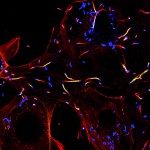Link to Pubmed [PMID] – 22908332
J. Immunol. 2012 Sep;189(6):2995-3006
Besides high-affinity IgE receptors (FcεRI), human basophils express activating (FcγRIIA) and inhibitory (FcγRIIB) low-affinity IgG receptors. IgG receptors (FcγR) were also found on mouse basophils, but not identified. We investigated in this study FcγR and the biological consequences of their engagement in basophils of the two species. We found the following: (1) that mouse basophils also express activating (FcγRIIIA) and inhibitory (FcγRIIB) low-affinity FcγR; (2) that activating FcγR can activate both human and mouse basophils, albeit with different efficacies; (3) that negative signals triggered by inhibitory FcγR are dominant over positive signals triggered by activating FcγR, thus preventing both human and mouse basophils from being activated by IgG immune complexes; (4) that the coengagement of FcεRI with inhibitory and activating FcγR results in a FcγRIIB-dependent inhibition of IgE-induced responses of both human and mouse basophils; (5) that FcγRIIB has a similar dominant inhibitory effect in basophils from virtually all normal donors; and (6) that IL-3 upregulates the expression of both activating and inhibitory FcγR on human basophils from normal donors, but further enhances FcγRIIB-dependent inhibition. FcγR therefore function as a regulatory module, made of two subunits with antagonistic properties, that prevents IgG-induced and controls IgE-induced basophil activation in both mice and humans.

